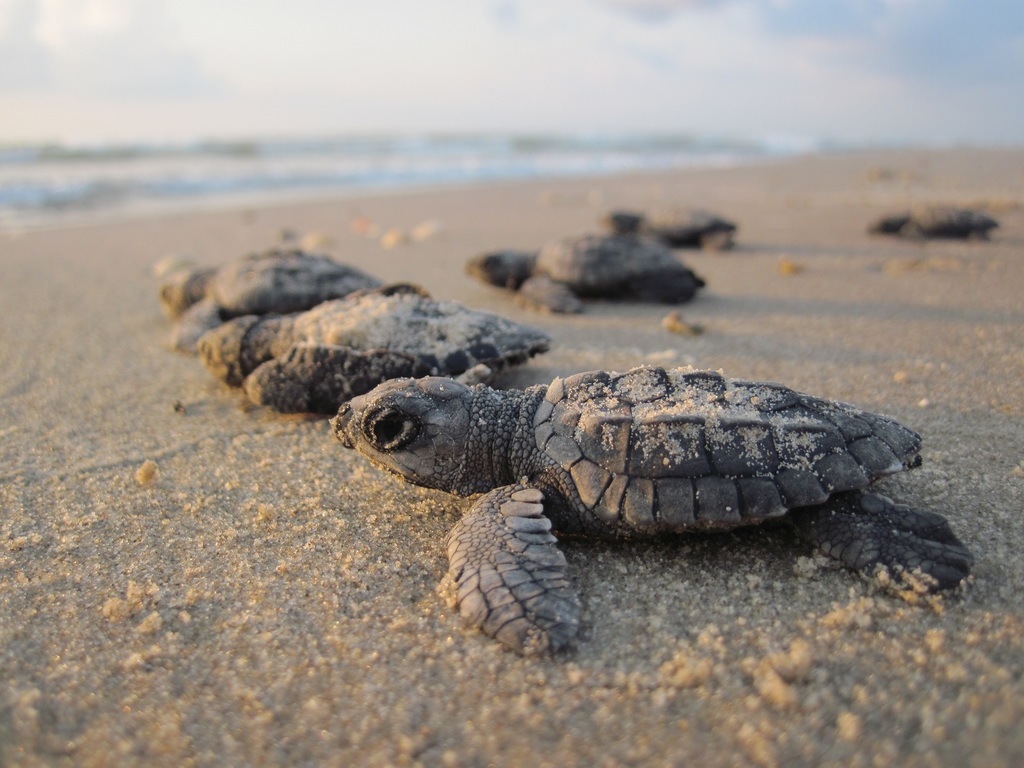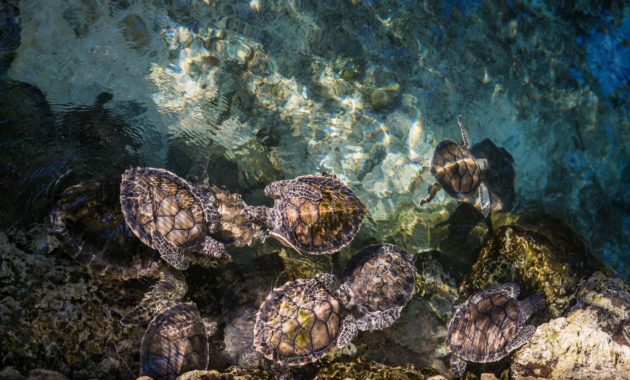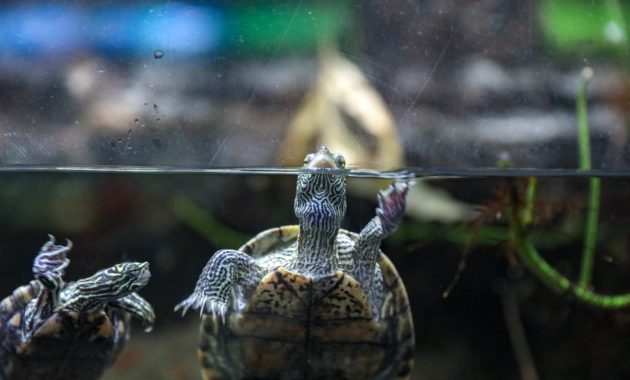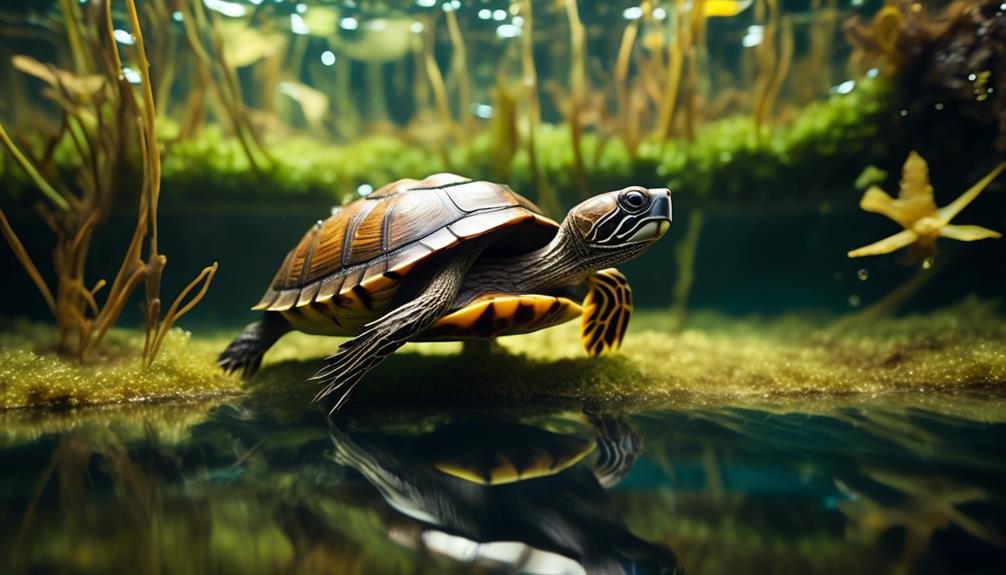
Dive into the captivating world of the Rare Wood Turtle, an aquatic species that will leave you spellbound. Just like a hidden treasure beneath the water’s surface, this unique turtle holds secrets waiting to be uncovered.
From its mesmerizing shell patterns to its graceful movements, the Wood Turtle is a true marvel of nature. But that’s not all – there’s so much more to discover about this fascinating creature.
Get ready to embark on a journey of exploration as we unveil the intriguing features and habits of the Rare Wood Turtle, leaving you eager to unearth the wonders that lie ahead.
Key Takeaways
- The North American Wood Turtle is a small, semi-aquatic turtle with a lifespan of 40-60 years.
- It is found in the northeastern United States, northern Virginia, southern Nova Scotia, and other areas.
- The Wood Turtle prefers slow-moving, cold water habitats that are unpolluted and shaded.
- To preserve the wild population, it is recommended to purchase Wood Turtles from reputable breeders.
Size and Lifespan
The North American Wood Turtle is a small, semi-aquatic species with a lifespan of 40-60 years. These turtles have a size that ranges from 5-8 inches in length, making them relatively small compared to other turtle species. Despite their small size, they’re known for their long lifespan, living up to several decades in the wild. This makes them a popular choice for turtle enthusiasts looking for a long-term companion.
The wood turtle’s semi-aquatic nature means that they spend a significant amount of time both in water and on land. They’re excellent swimmers, with slightly webbed feet and a strong tail that helps them maneuver through the water. On land, they’re known to roam near streams for food and egg-laying.
Habitat and Range
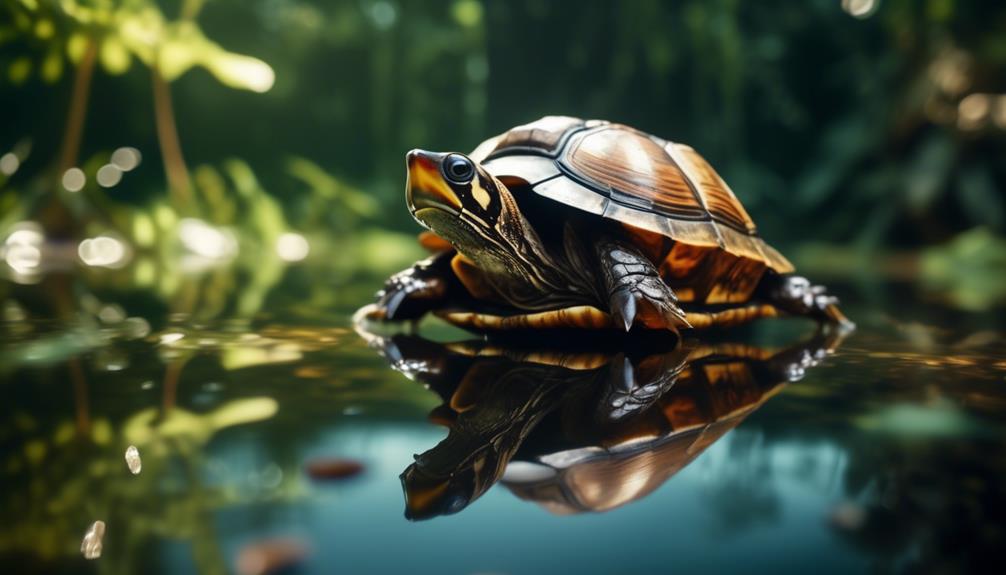
To understand the habitat and range of the North American Wood Turtle, it’s important to consider its preferred environment and geographic distribution.
Preferred Environment:
- Slow-moving, cold water
- Unpolluted and shaded
Geographic Distribution:
- Range includes northeastern United States, northern Virginia, southern Nova Scotia, eastern Minnesota, northeastern Iowa, southern Quebec
The North American Wood Turtle thrives in slow-moving, cold water that’s unpolluted and shaded. This type of habitat provides the ideal conditions for the turtle to live and thrive.
In terms of its geographic distribution, the range of the Wood Turtle includes northeastern United States, northern Virginia, southern Nova Scotia, eastern Minnesota, northeastern Iowa, and southern Quebec. These areas provide the necessary resources and conditions for the Wood Turtle’s survival.
Feeding Habits
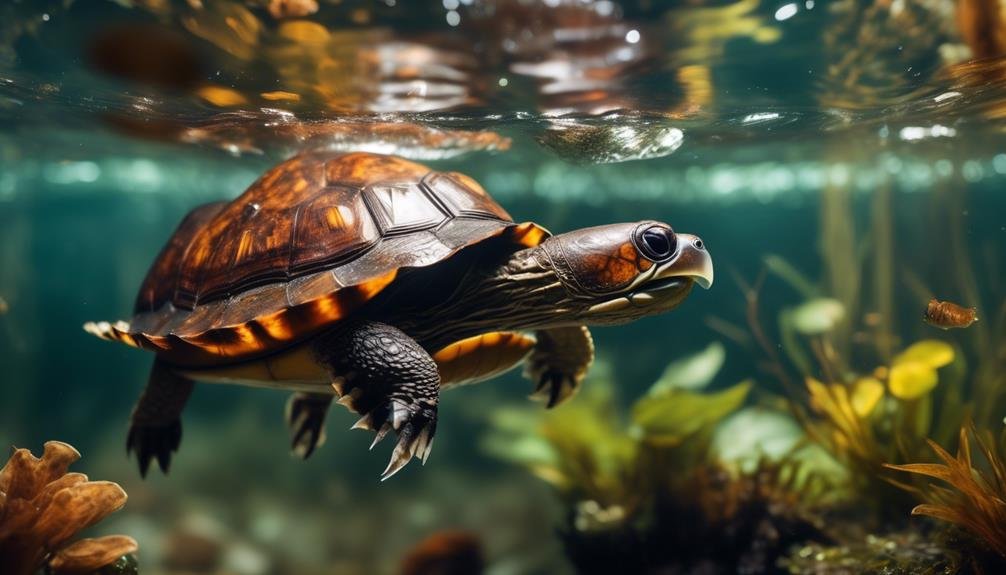
Now that we have explored the habitat and range of the North American Wood Turtle, let’s dive into its fascinating feeding habits. Wood turtles are omnivorous creatures, meaning they eat a variety of foods. They have a diverse diet consisting of commercial pelleted turtle diet, worms, crickets, insects, leafy greens, vegetables, and fruits. To give you a better idea of their feeding habits, here is a table showcasing their preferred food choices:
| Food | Description |
|---|---|
| Commercial pelleted turtle diet | Provides necessary nutrients |
| Worms | High in protein |
| Crickets | Good source of protein and calcium |
| Insects | Offer variety and stimulation |
| Leafy greens | Provide essential vitamins and minerals |
| Vegetables | Add dietary fiber |
| Fruits | Offer natural sugars for energy |
As you can see, wood turtles have a well-rounded diet that ensures they receive all the necessary nutrients for their survival.
Hibernation and Roaming Behavior
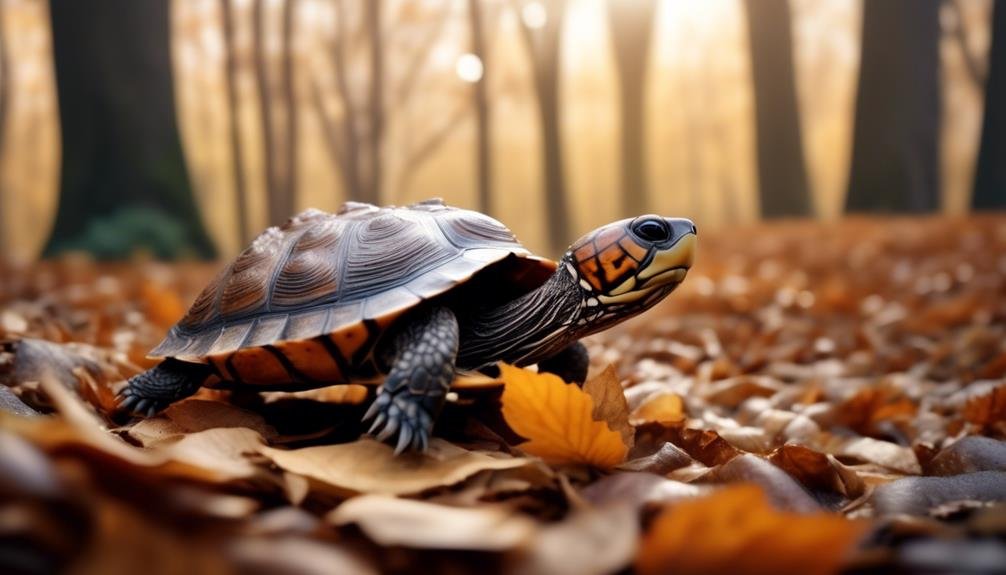
During the winter months, wood turtles enter a state of hibernation beneath the water in large streams and rivers. This hibernation period is crucial for their survival as it allows them to conserve energy and withstand the cold temperatures. The turtles bury themselves in the mud at the bottom of the water, where they remain dormant until the arrival of spring. Hibernation helps wood turtles avoid freezing temperatures and lack of food, as they rely on stored energy reserves during this time.
Once the hibernation period ends, wood turtles begin their roaming behavior, often moving on land near streams to find food and suitable nesting sites. They’ve been observed traveling long distances to search for food and mates, showcasing their adaptability and resourcefulness.
Preservation and Conservation
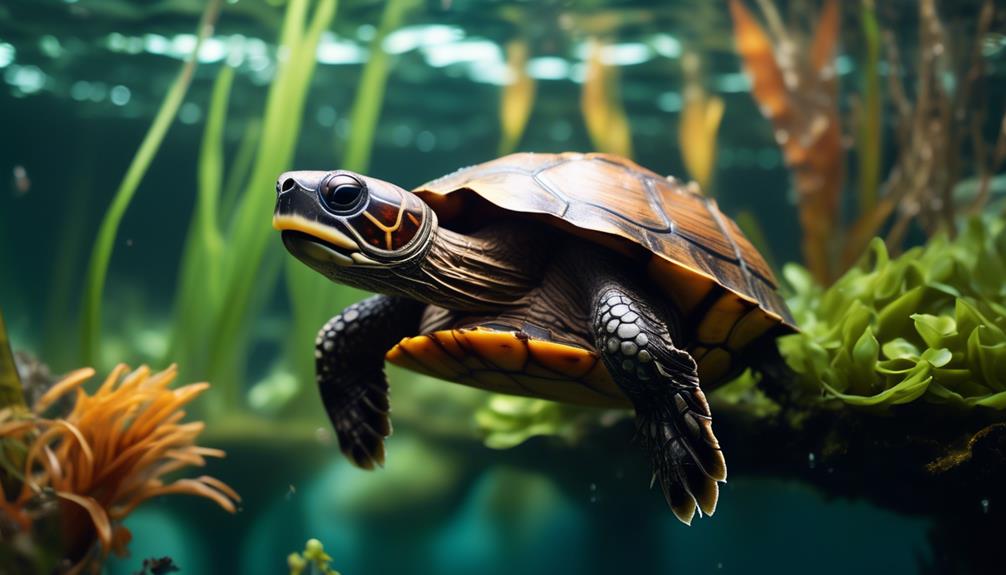
After discussing the hibernation and roaming behavior of wood turtles, it’s important to address the crucial topic of preserving and conserving this fascinating aquatic species.
Wood turtles are currently facing many threats to their survival, including habitat destruction, pollution, and illegal collection for the pet trade.
To preserve and conserve wood turtles, it’s essential to protect their natural habitats by enforcing stricter regulations on land development and water pollution.
Additionally, educating the public about the importance of these turtles and their conservation status can help raise awareness and support for their protection.
Engaging in breeding programs and promoting responsible pet ownership can also contribute to the preservation of wood turtle populations.
Distinctive Features and Physical Characteristics
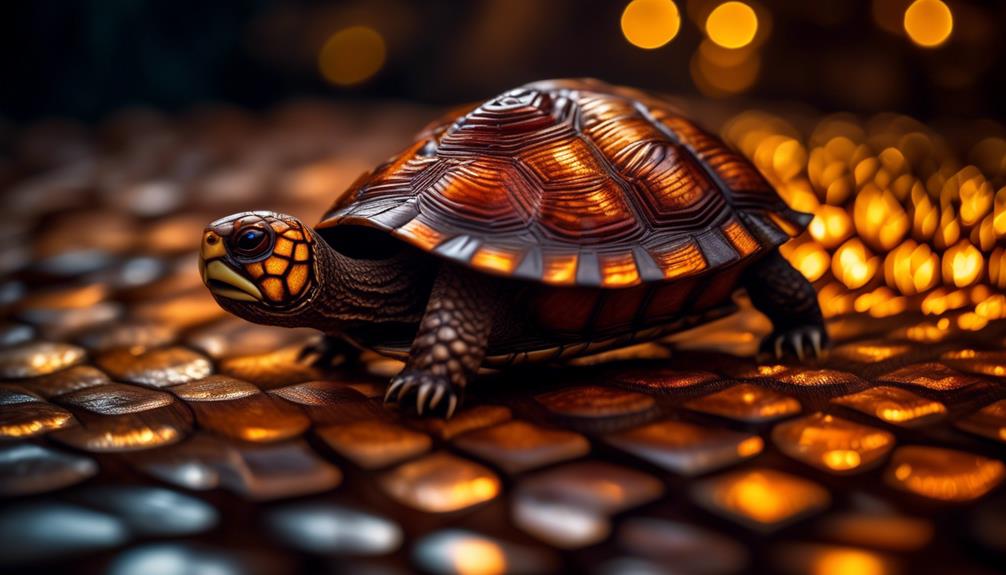
Wood turtles possess distinctive features and physical characteristics that make them a truly remarkable species. These unique traits contribute to their adaptability and survival in various environments.
- Shell: Wood turtles have a chiseled pattern on their shell, giving them a distinctive appearance. Additionally, they have a raised vertical line on their carapace, adding to their uniqueness.
- Limbs and Tail: These turtles have slightly webbed feet, making them strong swimmers. They also have a thick tail that aids in their movement through the water.
- Coloration: Wood turtles have a shell color ranging from brown to olive green. Their limbs and head are usually dark brown or black, with a red, orange, or yellow underside.
These physical characteristics, combined with their friendly and tame nature, make wood turtles a captivating species to observe and interact with.
Popular Breed and Shell Color
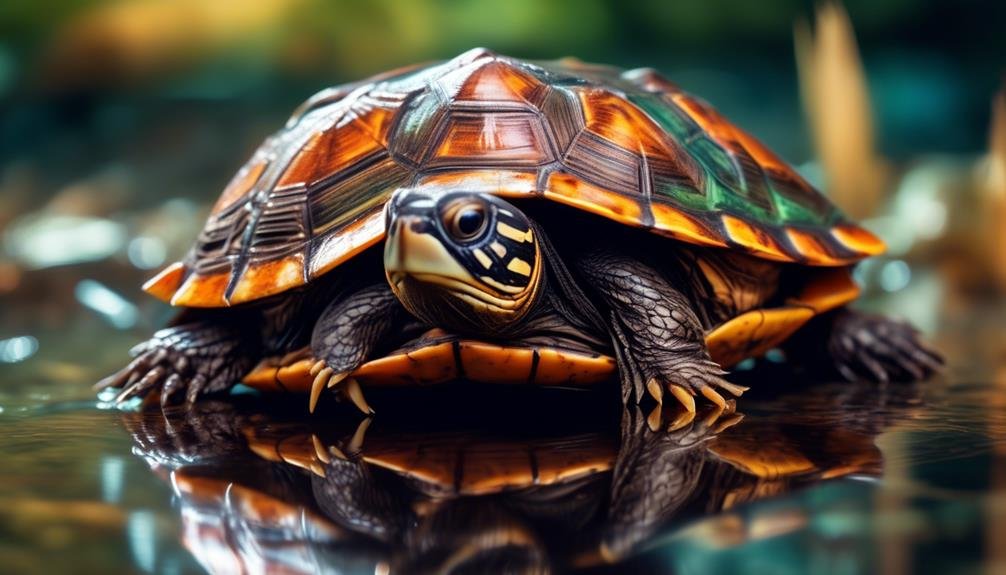
Wood turtles are known for their popularity as a breed and their unique shell colors. These turtles are highly sought after by reptile enthusiasts due to their friendly and tame nature, making them easy to handle and interact with.
Additionally, their shell colors add to their appeal, ranging from shades of brown to olive green. The distinct coloration of their limbs and head, which are usually dark brown or black with a red, orange, or yellow underside, further enhances their visual appeal.
The combination of their friendly temperament and striking shell colors make wood turtles a popular choice for turtle lovers and collectors alike.
Outdoor Enclosure and Predator Protection
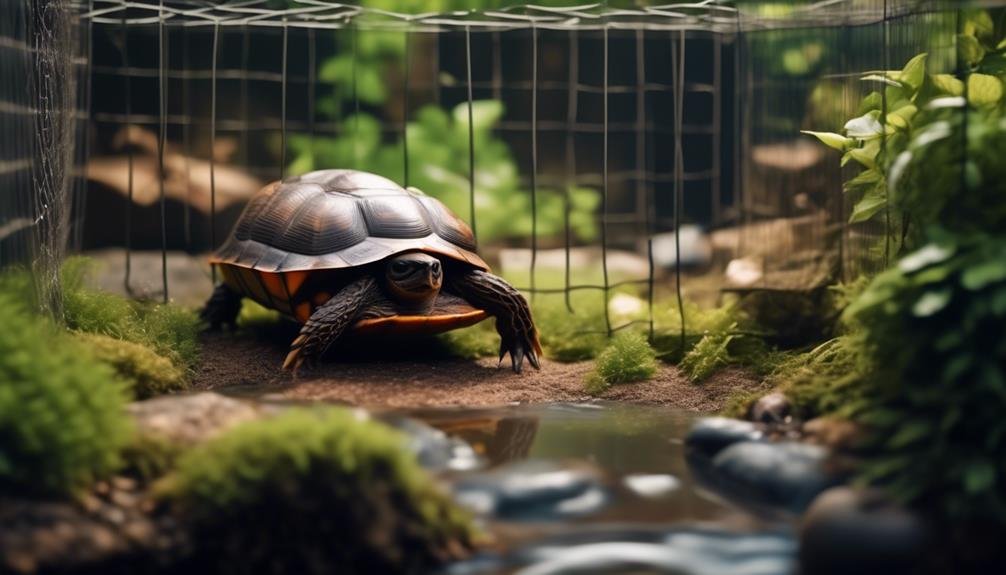
To provide the best living environment for wood turtles and ensure their safety from predators, it’s important to set up a secure outdoor enclosure. Here are some key points to consider:
- Structure:
- Use solid fencing material to prevent climbing or digging escape.
- Ensure the enclosure is tightly sealed to prevent small predators from entering.
- Size and Design:
- Provide a spacious enclosure of at least 5×5 feet for one adult turtle.
- Add an additional 4 square feet for each additional adult turtle.
- Create separate areas for land and water to accommodate their semi-aquatic nature.
- Land and Water Requirements:
- Maintain a minimum of 2 feet of water under 70°F.
- Include a shaded area for protection from direct sunlight.
- Use topsoil as substrate and provide sight barriers for multiple adults.
Water Requirements and Substrate
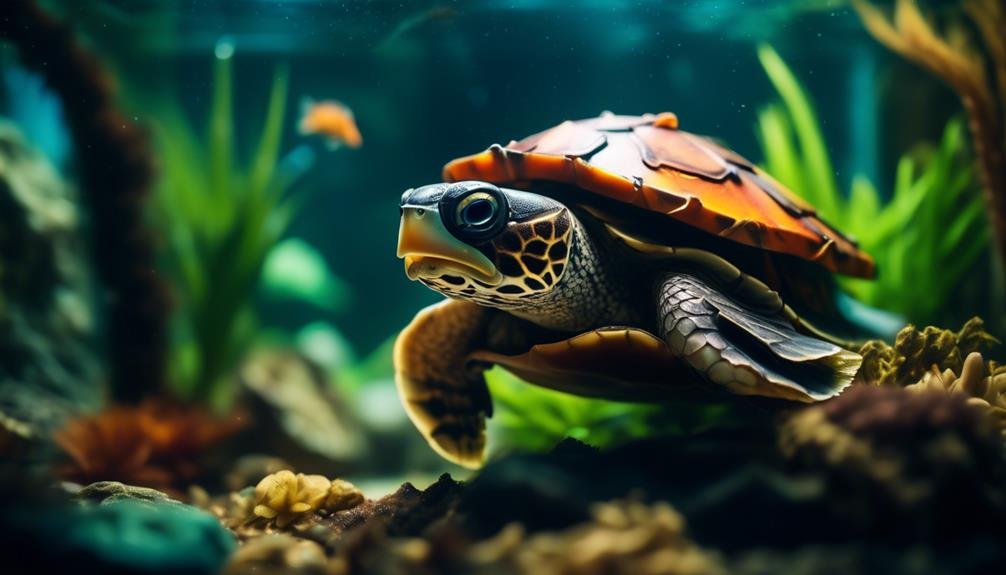
For optimal care of your wood turtle, it’s important to understand their specific water requirements and the type of substrate that best suits their needs.
Wood turtles are semi-aquatic, meaning they require both land and water areas in their enclosure. When it comes to water, they need a minimum of 2 feet of depth and a temperature under 70F. It’s also crucial to provide shade and a basking area for them to regulate their body temperature.
As for the substrate, using topsoil is recommended. This allows them to dig and burrow comfortably. Additionally, sight barriers should be provided if you have multiple wood turtles in the same enclosure to reduce stress and aggression.
Diet and Community Tank Compatibility
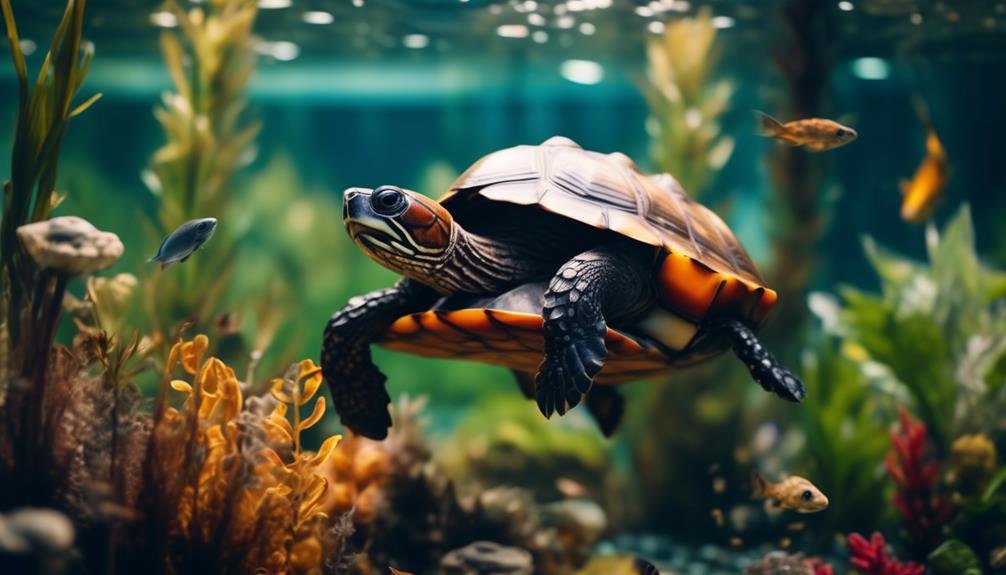
When caring for your wood turtle, it’s important to understand their dietary needs and their compatibility with other turtles in a community tank.
- Diet:
- Commercial pelleted turtle diet
- Worms, crickets, insects
- Leafy greens, vegetables, fruits
Wood turtles have an omnivorous diet that includes commercial pelleted turtle diet, worms, crickets, insects, leafy greens, vegetables, and fruits. Ensuring a balanced diet is essential for their overall health and well-being.
- Community Tank Compatibility:
- Can be kept with other Wood Turtles, Sliders, and Box Turtles
- Suitable for a community tank with one male per enclosure
When it comes to community tank compatibility, wood turtles can coexist with other wood turtles, sliders, and box turtles. However, it’s important to note that having only one male wood turtle per enclosure is recommended to avoid any potential aggression.
Handling and Behavior
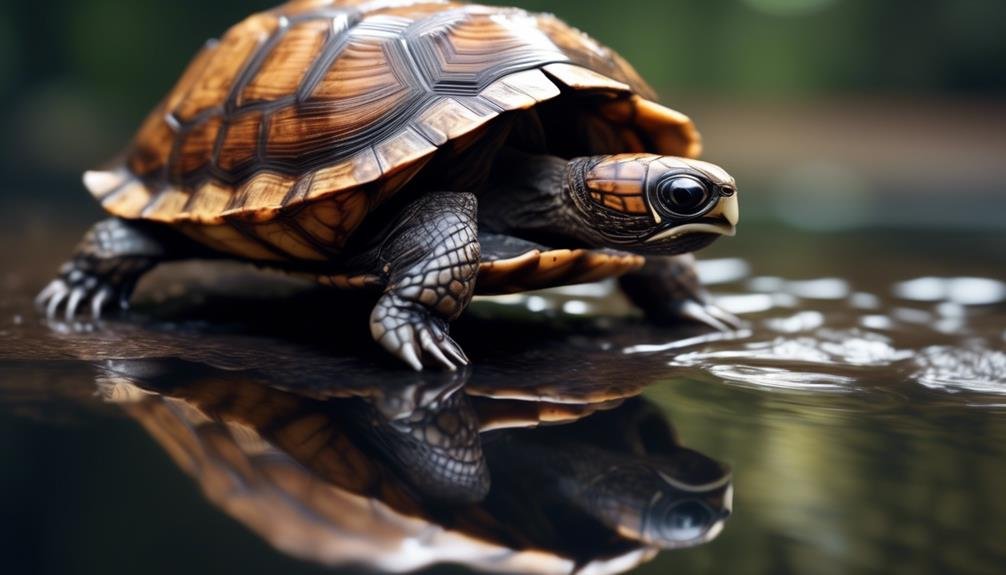
Handling wood turtles is an important aspect of their care as they exhibit personable behavior and can be easily picked up and handled with care. Wood turtles are known for their friendly and tame nature, making them suitable for handling and interaction.
When handling a wood turtle, it’s essential to approach them calmly and gently, avoiding sudden movements that may startle or stress them. Always make sure to support their body properly, keeping a firm yet gentle grip on their shell.
It’s important to note that wood turtles shouldn’t be handled excessively or for prolonged periods of time, as they still require their natural habitat and behaviors to thrive.
Care Certifications
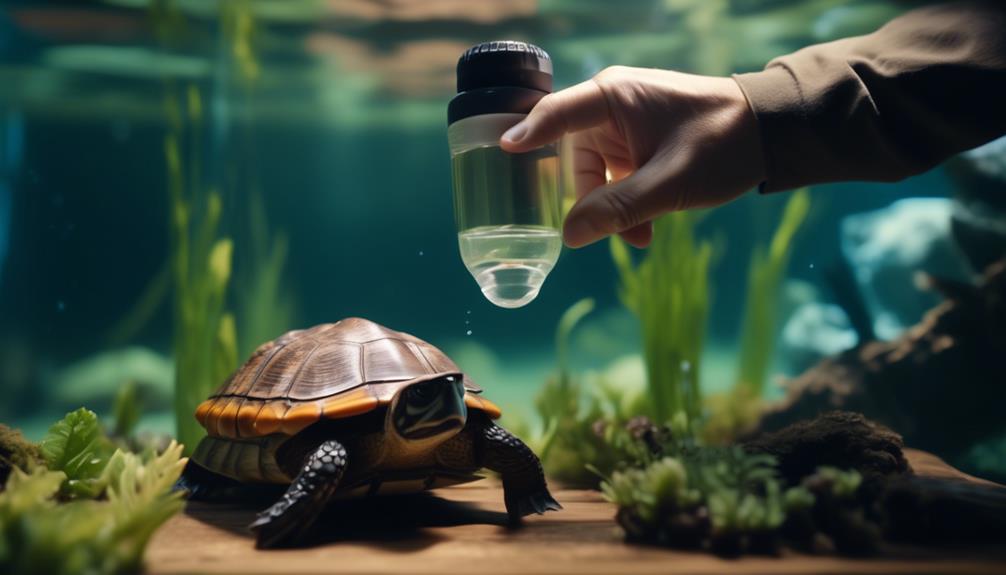
To ensure the best care for your wood turtle, it’s important to look for care certifications from reputable sources. These certifications indicate that the individual or organization has received proper training and education in turtle care.
When searching for care certifications for your wood turtle, consider the following:
- Reputable Sources:
- Look for certifications from well-known organizations, such as herpetological societies or wildlife rehabilitation centers.
- Check for certifications from experienced breeders or turtle enthusiasts who’ve a proven track record of successful turtle care.
- Comprehensive Knowledge:
- Ensure that the certification covers all aspects of wood turtle care, including habitat setup, feeding, health monitoring, and handling techniques.
- Look for certifications that emphasize the importance of preserving the species and promoting ethical breeding practices.
Importance of Staff in Doggie Daycare

The staff in a doggie daycare plays a crucial role in ensuring the safety and well-being of all the dogs in their care. They’re responsible for supervising the dogs during playtime, making sure that they’re playing nicely and not engaging in any aggressive behavior. The staff also monitors the dogs’ health and well-being, ensuring they’re eating properly and receiving any necessary medications.
Additionally, the staff provides mental and physical stimulation through interactive play and activities. They create a safe and clean environment for the dogs, regularly cleaning and sanitizing the daycare area. The staff also plays a vital role in socializing the dogs, helping them to develop good behavior and positive interactions with other dogs and humans.
Without a dedicated and knowledgeable staff, a doggie daycare wouldn’t be able to provide the level of care and attention that dogs need.
Indoor and Outdoor Space for Dogs
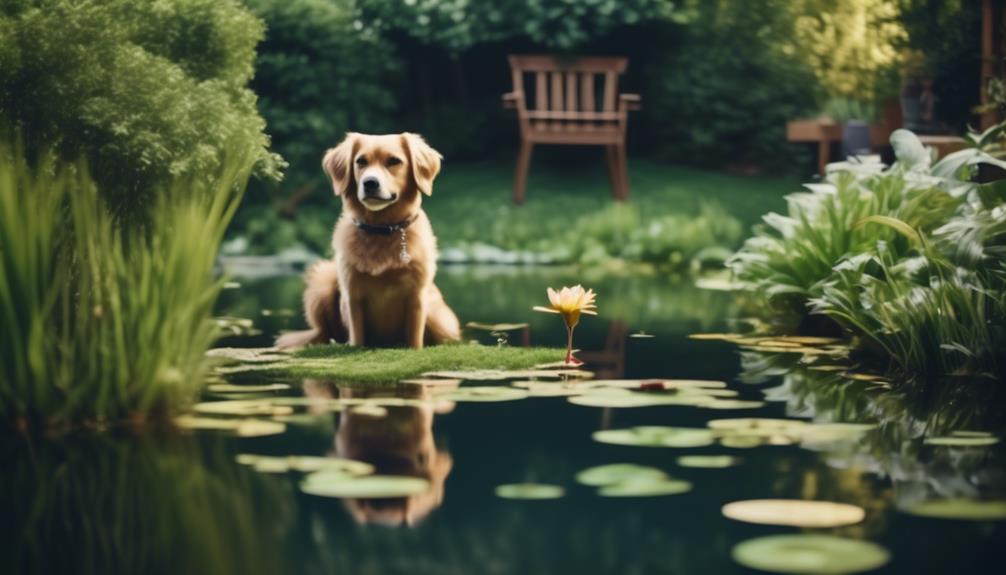
When considering the space requirements for dogs, it’s important to provide both indoor and outdoor areas for them to play and exercise.
- Indoor Space:
- Dogs should have 70 to 100 square feet of indoor space to play.
- Choose a daycare with experienced staff.
- Outdoor Space:
- Outdoor space should be large and secure.
- Look for positive reinforcement training methods.
Providing dogs with both indoor and outdoor space allows them to fulfill their natural instincts and stay physically and mentally stimulated. Indoor space gives them a controlled environment to play and interact with other dogs, while outdoor space allows them to run, explore, and breathe in fresh air.
It’s crucial to ensure that both the indoor and outdoor areas are safe and secure, with proper fencing or enclosures to prevent escapes or accidents. Additionally, selecting a daycare with experienced staff who use positive reinforcement training methods ensures that dogs receive the necessary guidance and supervision while enjoying their playtime.
Bubbletastic Dog Bubble Machine

Introduce your furry friend to hours of endless fun with the Bubbletastic Dog Bubble Machine! This amazing machine blows bacon-scented bubbles that dogs absolutely love chasing and popping.
Not only will it provide your dog with hours of entertainment, but it will also bring joy to you as you watch your pet have a blast.
The bubbles produced by the machine are completely non-toxic and safe for both dogs and kids, giving you peace of mind while your dog enjoys the playtime.
If you’re interested in getting the Bubbletastic Dog Bubble Machine for your furry companion, you can find it available for purchase on the Active Dog Toys website.
Get ready for some bubbletastic fun that will make your dog’s tail wag with excitement!
Frequently Asked Questions
How Can I Contribute to the Preservation and Conservation of the Wood Turtle Species?
You can contribute to the preservation and conservation of the wood turtle species by purchasing from reputable breeders, creating a secure enclosure, providing suitable habitat, and promoting awareness about the importance of protecting these fascinating aquatic creatures.
What Are the Distinctive Features and Physical Characteristics of the Wood Turtle?
The wood turtle has distinct features like a chiseled pattern on its shell and a raised vertical line on its carapace. It has slightly webbed feet, is a strong swimmer, and has a thick tail.
Are Wood Turtles a Popular Breed Among Turtle Enthusiasts?
Wood turtles are not as popular as some other turtle breeds, but they are still loved by enthusiasts. Their friendly and tame nature, along with their unique chiseled pattern on the shell, make them a fascinating choice for turtle lovers.
What Are the Water Requirements and Recommended Substrate for Wood Turtles?
For water requirements, maintain a minimum of 2 feet of water under 70F. Provide shade and a basking area. As for substrate, use topsoil. Remember, these guidelines are for wood turtles.
Can Wood Turtles Be Kept in a Community Tank With Other Turtle Species?
Yes, wood turtles can be kept in a community tank with other turtle species like sliders and box turtles. They are friendly and suitable for a community tank, but make sure to have one male per enclosure.
What are the similarities and differences between the North American Wood Turtle and the Black Wood Turtle?
The North American Wood Turtle and the Black Wood Turtle share similar dark carapaces, but the former has a lighter underside while the latter has a yellow or brown plastron. Both are semiaquatic and omnivorous, yet the fascinating black wood turtle is more commonly found in South Asia.
Conclusion
In conclusion, the North American Wood Turtle is a captivating and rare aquatic species that makes for a delightful and long-term companion. With its unique characteristics and strong swimming abilities, this turtle is sure to capture your attention.
By purchasing from reputable breeders, you can contribute to the conservation of this remarkable species. So why wait? Bring the wonder of the Wood Turtle into your life and make a difference in preserving wild populations.

